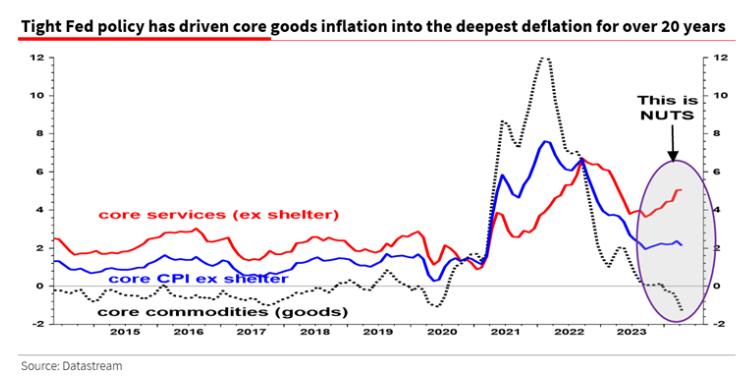Inflation or deflation? Both sides of US inflation are ice and fire
This article uses automatic translation for some of its parts
Both the April US Consumer Price Index (CPI) and retail sales, which were announced last week, cooled down, giving vitality to the market. As a result, US stocks hit an all-time high during the day last week.
However, Albert Edwards, a well-known strategist at Societe Generale, pointed out that the current inflation problem facing the US is much more complicated than the market thought, and stated that “the Fed is also sowing a new kind of policy disaster.”
In the latest report, he pointed out that despite falling headline inflation, core service inflation, which is extremely sticky, continues to maintain inflation levels and is insensitive to the Fed's policies.
Mr. Edwards pointed out that the Fed tried to suppress the rise in supercore service inflation (supercore services inflation, core services inflation rate excluding housing, etc.) by keeping interest rates high. However, he points out that this has led to unprecedented deflation of core goods inflation (core goods inflation).

He points out that the Fed is likely to target things that cannot be controlled and cause unprecedented goods deflation (goods deflation).
Whereas core goods inflation has fallen to its lowest level in the past 20 years, supercore service inflation was not affected by rising interest rates due to the drive of sectors less affected by interest rates, and it has returned to an upward trend.

For example, the inflation rate for transportation services surged to 11.2% compared to the previous year (accounting for 6.5% of total CPI and 15% of supercore CPI). In particular, car insurance premiums have reached an astonishing figure of 22.6% compared to the previous year. Price increases in these sectors became the main driving force behind supercore service inflation, which was beyond the control of the Federal Reserve and unaffected by high interest rates.

In response to this, Mr. Edwards points out that the policy line where the Fed pursues a 2% inflation target to restore honor is the same as the mistake made after the 2008 financial crisis (after the financial crisis, the Fed implemented an excessively accommodative monetary policy to achieve the 2% inflation target, which led to a series of economic bubbles).
Former Federal Reserve Chairman Paul Volcker also criticized that excessive pursuit of the 2% inflation target will lead to economic distortions and speculative bubbles. Volcker says that when measurement errors are taken into account, strictly achieving the 2% inflation target is itself a policy error.
— MooMoo News Zeber
Source: Bloomberg, Datastream
This article uses automatic translation for some of its parts
Source: Bloomberg, Datastream
This article uses automatic translation for some of its parts
Disclaimer: Moomoo Technologies Inc. is providing this content for information and educational use only.
Read more
Comment
Sign in to post a comment

ニックネーム、 : It looks like it's still going up@SIHROMAFU
ポイゴン : I wonder if the policy interest rate of about 3% is about to drop?